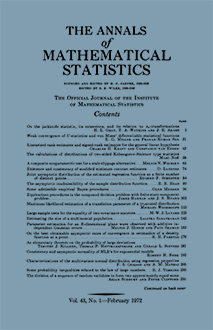Abstract
Let $x_1 < x_2 M \cdots < x_n$ and $y_1 < y_2 < \cdot < y_m$ be the ordered results of two random samples from populations having continuous cumulative distribution functions $F(x)$ and $G(x)$ respectively. Let $S_n(x) = K/n$ when $k$ is the number of observed values of $X$ which are less than or equal to $x$, and similarly let $S'_m(y) = j/m$ where $j$ is the number of observed values of $Y$ which are less than or equal to $y$. The statistic $d = \max | S_n(x) - S'_m(x) |$ can be used to test the hypothesis $F(x) \equiv G(x)$, where the hypothesis would be rejected if the observed $d$ is significantly large. The limiting distribution of $d \sqrt{mn}{m + n}$ has been derived [1] and [4], and tabled [5]. In this paper a method of obtaining the exact distribution of $d$ for small samples is described, and a short table for equal size samples is included. The general technique is that used by the author for the single sample case [2]. There is a lower bound to the power of the test against any specified alternative, [3]. This lower bound approaches one as $n$ and $m$ approach infinity proving that the test is consistent.
Citation
Frank J. Massey Jr.. "The Distribution of the Maximum Deviation Between two Sample Cumulative Step Functions." Ann. Math. Statist. 22 (1) 125 - 128, March, 1951. https://doi.org/10.1214/aoms/1177729703
Information





